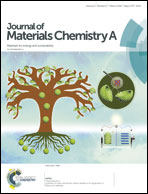High-efficiency bulk heterojunction perovskite solar cell fabricated by one-step solution process using single solvent: synthesis and characterization of material and film formation mechanism†
Abstract
Bulk heterojunction (BHJ) perovskite solar cells have recently attracted increased interest because of a significantly enhanced interface between perovskite and the n-type material in the active layer for efficient charge separation and increased power conversion efficiency (PCE). [6,6]-Phenyl-C61-butyric acid methyl ester (PC61BM) is the most commonly used n-type material in BHJ perovskite solar cells owing to its high electron mobility. However, it is very difficult to fabricate BHJ perovskite films because of the poor solubility of PC61BM in the commonly used solvent dimethylformamide (DMF). In this study, we introduced two kinds of fluorinated PC61BM (3F-PC61BM and 5F-PC61BM) as n-type materials in a BHJ perovskite film, which have higher solubility in DMF than that of PC61BM. Thus, a BHJ perovskite film can be easily fabricated in one step using a single solvent in a BHJ precursor solution system for planar perovskite solar cells. A BHJ device with a high PCE of 16.17% can be obtained by adding 0.1 wt% of 3F-PC61BM in a perovskite precursor solution to fabricate a solar cell, which outperforms the PCE of 14.12% of the pristine device. However, the addition of 5F-PC61BM decreased the PCE to lower than that of the pristine device regardless of its amount. We systematically studied the effects of the amount and type of fluorinated PC61BM on the morphology of BHJ perovskite films using SEM, AFM, GISAXS and GIWAXS. The results reveal that 3F-PC61BM can fill the pinholes between perovskite grains and passivate the defects in the pristine film. Thus, the current density (Jsc) is greatly increased. On the other hand, the self-aggregation of 5F-PC61BM in BHJ perovskite films caused the films to be full of large voids, which led to poor device performance. The dense and flat surface morphology of BHJ perovskite films containing 3F-PC61BM can also prevent the permeation of moisture into grain boundaries and enhance the device stability. Therefore, the device could maintain 80% of its original efficiency over 550 hours without any encapsulation in comparison with 240 hours for the pristine device. Our results provide a novel strategy for fabricating high-PCE and high-stability BHJ perovskite solar cells for the production of low-cost solar cells in the near future.



 Please wait while we load your content...
Please wait while we load your content...